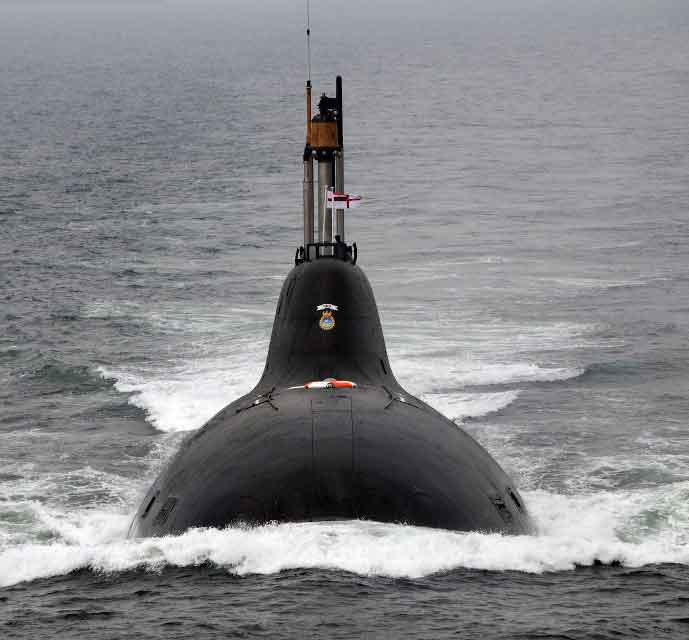Aircraft carriers and other warships are all visible platforms on sea. However, navies worldwide operate vessels that are largely unseen, which lurk undetected beneath the sea but are capable of sinking even the mightiest of warships single-handedly. These are submarines, also referred to as boats and never really by any other description. Submarines are considered one of the world’s most powerful military machines. Over 500 submarines patrol the world’s oceans. Nuclear missile capable submarines (SSBNs) carry half the nuclear arsenal of the world.
Nuclear missile capable submarines carry half the nuclear arsenal of the world.
The erstwhile USSR first offered India eight Type 641 ‘Foxtrot’ class submarines in 1964. INS Kalvari was the first Indian submarine to be commissioned in 1967. Three more submarines of this class were commissioned years before the 1971 war, while others joined later. Now, in addition to the conventional ones, the Indian Navy also operates nuclear-powered submarines. Curiously, it may be recalled that the first Indian to have made a passage on a submarine was not a naval sailor, but a civilian. Netaji Subhas Chandra Bose made good an escape from Germany to Japan in 1942 on submarines of the two nations, which included a transfer mid-sea.
It is the only recorded civilian passage on board any naval submarines till date. Incidentally, the naval base in Kolkata is named INS Netaji Subhas, as are the airport and few other iconic landmarks in the city and elsewhere. Incidentally, the Naval Republic Day-2014 tableaux at Kolkata will also feature a submarine model. One cannot help but marvel at this intricate black giant metallic shell, which when dry-docked with several umbilical contraptions sticking out, looks like an unseemly sight against the backdrop of other majestic looking ships.
Yet the alluring aura of a submarine attracts intrepid seamen, whose resolve is harder than any known steel alloy, whose grit is far stronger than average mortals and whose ability is to withstand pressures of all unimaginable proportions. Anyone who possesses few of these attributes can hope to fit the bill to be a ‘submariner’, provided he earns the coveted ‘Dolphin’ badge after qualifying the rigorous selection and training and he lives a cherished life ‘sub-marine’ (under water), quite like a dolphin.
Vice Admiral Pradeep K Chatterjee, Deputy Chief of Naval Staff at the Integrated Headquarters of Ministry of Defence (Navy), who is the first-ever Submariner Deputy Chief of Naval Staff and currently the senior most serving ‘submariner’ in the Indian Navy, was a young Sub-Lieutenant in 1977, when he chanced one fleeting glance of a submarine that had just passed by his ship. It was to be his moment of reckoning. Like many others of his ilk, a closer look at the submarine docked in the yard was all it took him to decide and later spend a significant part of his naval career fathoming beneath the sea, a life unparalleled that only a few dare, and qualify.
The submarine is among a country’s most economical weapon. Comprising only 1.6 per cent of the Navy’s World War-II personnel, the submarine service accounted for nearly 55 per cent of all enemy ships destroyed.
“To be a submariner, one has to be highly motivated. It is purely a voluntary arm,” he says. “But that doesn’t guarantee that you will be a submariner,” he clarifies. There are several attributes that one has to be comfortable with to be a submariner. To begin with, if one feels claustrophobic in a confined space, there is literally no room for you, he adds. Bravery and courage are also facets that do not matter if one cannot cope with the tough routine here, says the Admiral. The process of training is, therefore, extremely rigorous, as the team is only as strong as its weakest link. There is heavy dependence on each other for safe and successful missions.
For a submariner, the intricate knowledge of technicalities of the submarine and its equipment is integral for survival. Despite its compactness, there is room for everything inside except a mistake, submariners say. Per cubic inch, there is more science packed into a submarine than into any other warship.
What kind of man is then a submariner?
“He is someone who is adventurous, confident, group-oriented and self-motivated, usually someone who is quiet, patient and can handle anxiety well,” sums up Surgeon Captain Kaushik Chatterjee, Senior Advisor (Psychiatry) at Command Hospital, Kolkata. An experienced submariner is typically comfortable in groups, open to experience, agreeable and conscientious. In short, someone who can continue patiently do his job with nerves of steel, while around him, all hell is breaking loose.
Importance of submarines
Highly capable, multi-mission submarines are cost-effective to operate over their service life. The upfront investments pay dividends over the long term in operating savings, particularly since modern nuclear submarines have fuel for the life of the ship built into the nuclear reactor core. They require no replenishment-at-sea or protective escorts. A capable submarine will be able to operate in difficult circumstances and provide a ‘strategic impact’ that would make a potential aggressor avoid a military confrontation. They offer the ultimate in stealth and surprise while influencing events in the other domains of land, air and sea.
A ballistic missile can be fired with an accuracy of few feet over a distance of 12,000 km. SSBN submarine can carry 16-24 such missiles, enough to destroy several cities at once.
Large submarines are able to operate at a long range for weeks carrying a flexible payload of sensors, weapons and specialist personnel. In the surveillance role, submarines can simultaneously observe activities under water, on the surface, in the air and over the electromagnetic spectrum, often in areas beyond conventional eyes and ears. The submarine is among a country’s most economical weapon. Comprising only 1.6 per cent of the Navy’s World War-II personnel, the submarine service accounted for nearly 55 per cent of all enemy ships destroyed. Modern submarines can travel faster. They can fully submerge in less than a minute. Both nuclear and modern diesel-powered submarines are equipped with a breathing device known as a snorkel, which permits the vessel to draw fresh air from the surface while running submerged.
Submarines names and classification Navies worldwide usually name their submarines after sharks, killer whales, stingray and similar other blood-thirsty marine animals. The Indian submarines derive their Sanskrit names from the predatory denizens found in deep Indian waters or as avengers in the marine world. The names are usually in the languages of our coastal states. Submarines are essentially of three types, based on their propulsion and warhead-carrying capability. These are the SSBN (ship, submersible, ballistic, nuclear), SSN (ship, submersible, nuclear) and the conventional SSK (sub surface killer). With the induction of INS Chakra (SSN), on April 4, 2012, and to be inducted INS Arihant (SSBN), the Indian submarine fleet is as potent as any, in the world.
The SSBN or the ballistic missile-carrying submarines carry an amazing power of annihilation. A ballistic missile can be fired with an accuracy of few feet over a distance of 12,000 km. SSBN submarine can carry 16-24 such missiles, enough to destroy several cities at once. Each missile has MIRVs or multiple independent re-entry vehicles, which can be directed at various locations. Each of these missiles usually carries a 100 KT nuclear warhead, which is nearly six times more powerful than the atomic bomb that was dropped over Hiroshima.
Like all manmade vessels, redundancy and mechanical failures along with other hazards and emergency on board can put lives at peril in any class of submarine.
Dangers that besiege submarines
Lurking beneath the ocean to sink enemy ships undetected has been the theme of many a Hollywood movie. While it may seem an all-out adventure, the submarine is also an easy target to destroy, if detected. There is no escaping from a deathly burial at sea even before having an opportunity to surface. Like all manmade vessels, redundancy and mechanical failures along with other hazards and emergency on board can put lives at peril in any class of submarine. It is under such circumstances that each crew looks up to their officers for strength, conviction and courage. Such encounters truly test the mettle of even the most experienced submariners.
“Fear is a factor that should never be seen by others in your eyes. Your men know the danger when there is one but they take courage from your actions and conduct,” says veteran submariner, Admiral Chatterjee, hence the emphasis on rigorous training and knowing your submarine inside out. While lapses by erring individuals are given a resounding dressing down by seniors in full view of the submarine complement, there is also no room for any pretence. Perhaps that is why submariners bond extremely well. Today, while occupying a very high rank and appointment at the Naval Headquarters, Admiral Chatterjee admits to receiving calls from old retired submarine mates, who out of the camaraderie and bonhomie that exists between them still love to share the happy moments that happen to them and their families for old time’s sake.
When asked if he would be willing to trade places if given a chance to go back to a submarine, Admiral Chatterjee quite candidly admits, he would. But as a true professional, he knows only too well that while his heart and mind may always dive with the submarines, the fitness level required at his age and seniority may come in the way of being an active submariner again. But if you are a youth who seeks an adventure-filled life, then there can be no better place on earth than taking to voyages and dives beneath the sea. That dream can only be fulfilled if you choose to join the Indian Navy.







Indian Navy’s submarine fleet is in a pathetic state. With just 13 submarines ( 9 kilo & 4 HDW), it is just 20% of the combined strength of China and Pakistan. Further no sub has been inducted since 2000, i.e. nearly 14 years. This wing of the Indian navy is grossed equipped. India should immediately take steps to increase the strength to get a ratio of at least 1:1, if not more. Ideally the ratio should be 2:1 in favour of India, since India has the option of importing from multiple countries, which China does not. India should go for 2 types of SSK submarine under project P75i. India should opt for 36 submarines of each type, 50% imported and rest manufactured in India. India should also increase the scorpene deal to 36 from the current 6. Emphasis should be given on early induction and not indigenous manufacturing alone, in the wake of deteriorating strength. This will take the strength to 108, with enough submarines to be deployed both in west asia and south china sea to secure our energy supply and counter china respectively. With availability at around 60-70%, we will have around 70 submarines all the time. Further India should also build around 30 to 60 SSBN’s to complete the nuclear triad. The ballistic missiles onboard should have a range of atleast 6000kms, so that it can hit any part of China. Majority of the nuclear assets should be under naval control, as this will give a credible second strike option, irrespective of who strikes first. Further SSN should be developed to replace the SSK’s fleet in the long run. However, since SSK’s are much stealther and less noisy compared to SSN’s, we should also retain the option to induct SSK’s also. India should also develop 10-15 aircraft carriers in the next 20 years. The submarines should be part of the carrier battle groups (CBG’s) to be more effective in case of a war.
India should this, India should that, you forgot to mention that India should get its economy up and find the money first… that is, even if you don’t care to take care of your dirt-poor citizens first.